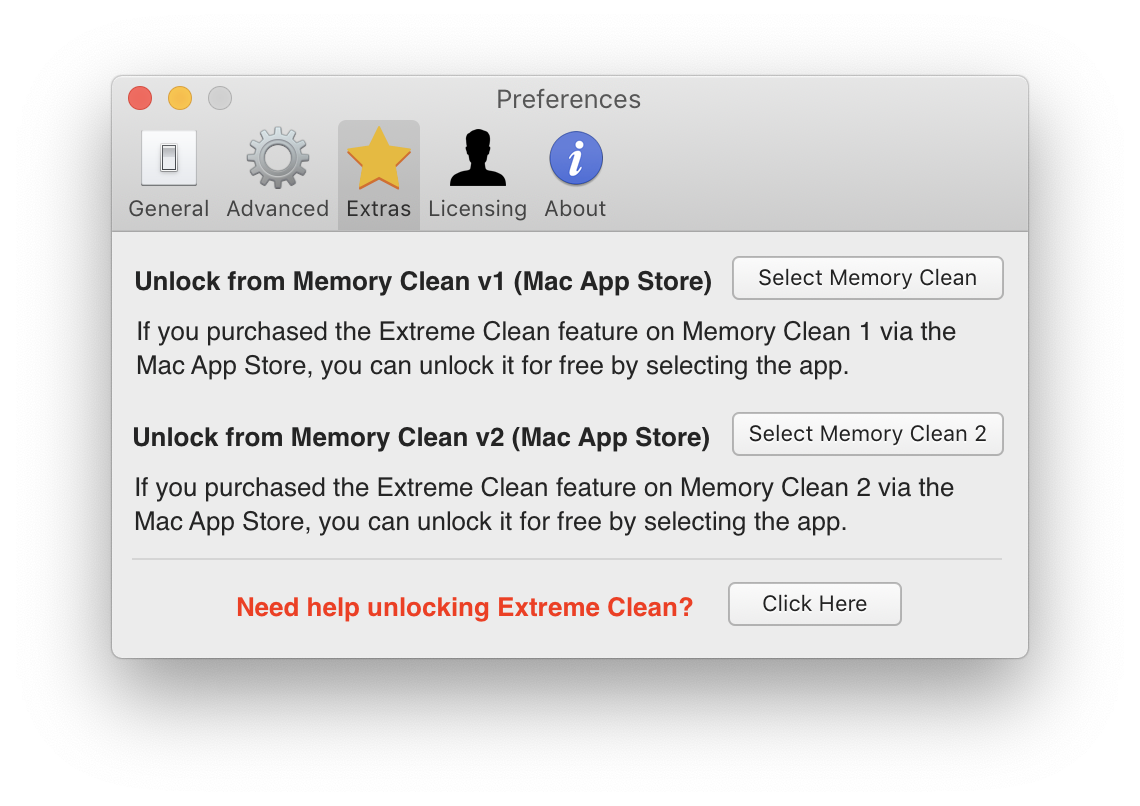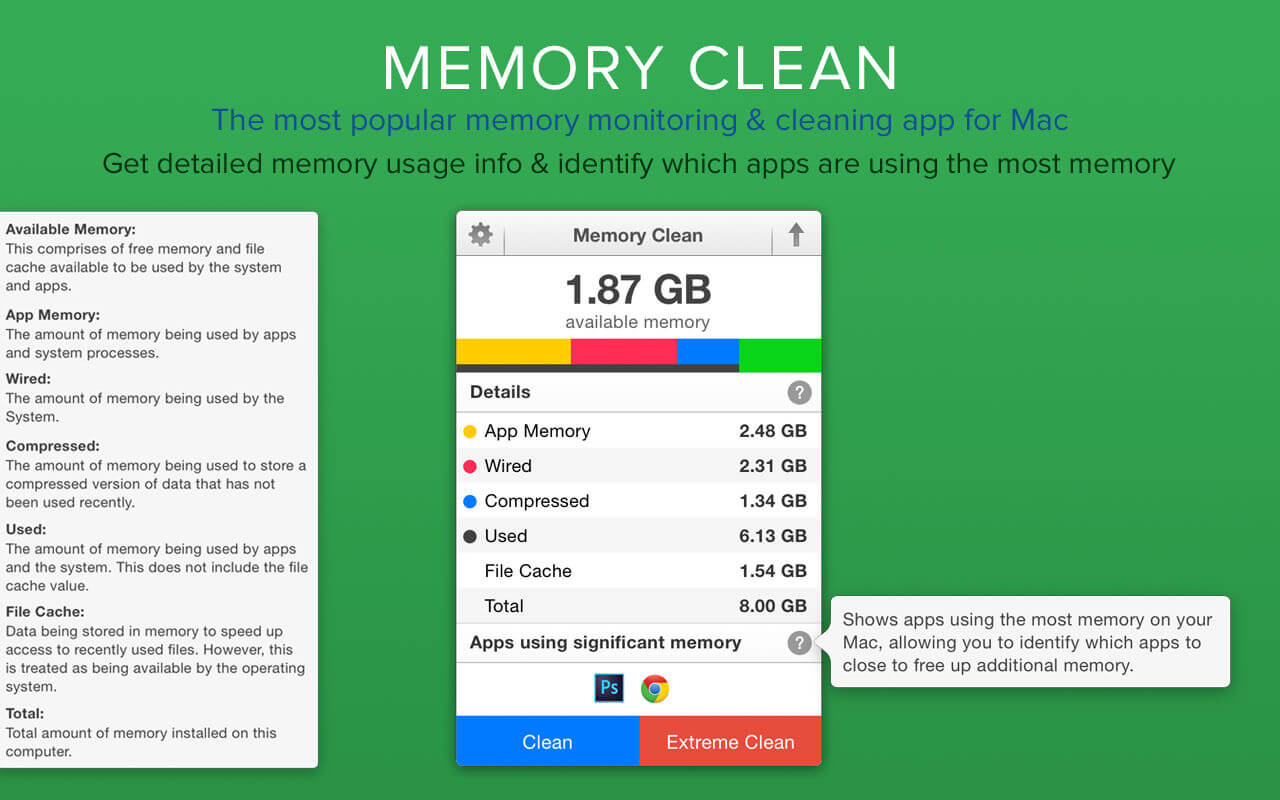A minimalist status bar menu application designed to help you optimize your Mac's memory usage by quickly freeing the unused RAM
- Entering cat /proc/meminfo in your terminal opens the /proc/meminfo file. This is a virtual file that reports the amount of available and used memory. It contains real-time information about the system’s memory usage as well as the buffers and shared memory used by the kernel.
- Memory Clean 2 از شرکت Fliplab. با Memory Clean 2 حافظهٔ غیرفعال مک شما پاک خواهد شد - کاری که ممکن است بعد از بستن یک برنامه یا بازی مخصوصاً پرمصرف انجام دهید.
- Memory Clean is an app for cleaning up your Mac OS X device memory at intervals. Memory Clean is available from the App Store or several download sites, and installs easily. Memory Clean is a free.
What's new in Memory Clean 3 1.0.20:
Confirm you are running Memory Clean 2 (Direct) v2.0.4 or higher. You can do this by opening the app's Preferences and checking the 'About' section. If you are running a version below v2.0.4, update the app by right clicking on the menubar icon and selecting 'Check for Updates'.
- Bug fixes
Whenever you finish working with an application that takes a big chunk of your resources it is advisable to purge your Mac’s memory on your own in order to get your system back to normal as soon as possible.
Memory Clean 2 From Flip Lab Free
Minimalist and low-key memory monitoring and optimization for both beginner and advanced users
Memory Clean is a simple status bar menu application that can asses the current status of your RAM, display a colorful graph taking into account the current memory statistics and then help you free up memory with a simple click of a mouse button.
By default, Memory Clean will show the amount of free memory in the status bar icon. If you press it, you will be able to view other details in a separate window: the amount of active, wired, inactive, free and used memory, but also a total.
Furthermore, in order to optimize your Mac's memory usage you have to simply click the “Clean Memory” button at the bottom of Memory Clean's main window.
Built-in 'Auto Clean' feature designed to completely automate the RAM cleaning process
The same information is available in the status bar menu if you right click on the Memory Clean icon. In addition, you can access the app’s preferences and change the default text style and size, the threshold level or the refresh interval.
What’s more, you can enable the “Auto Clean” function which will trigger the cleaning process if the free memory drops below the threshold. Keep in mind that your computer might not function properly during the cleaning process.
Intuitive memory tracker that also makes it easy and quick to set your RAM free
All in all, if you're looking for minimalist macOS application designed to help you free up some of your Mac's RAM, as well as keep a close eye on its memory usage, without cluttering your desktop, Memory Clean is probably you're best bet.
Filed under
Memory Clean 3 was reviewed by Sergiu Gatlan- The extreme cleaning feature is disabled.
- 64-bit processor
Memory Clean 3 1.0.20
Softpedia Editor's Pickadd to watchlistsend us an update- runs on:
- OS X 10.9 or later (Intel only)
- file size:
- 7.6 MB
- filename:
- Memory_Clean_3.zip
- main category:
- Utilities
- developer:
- visit homepage
top alternatives FREE
top alternatives PAID
-->This article applies to: ✔️ .NET Core 3.1 SDK and later versions
A memory leak may happen when your app references objects that it no longer needs to perform the desired task. Referencing said objects makes the garbage collector to be unable to reclaim the memory used, often resulting in performance degradation and potentially end up throwing a OutOfMemoryException.

This tutorial demonstrates the tools to analyze a memory leak in a .NET Core app using the .NET diagnostics CLI tools. If you are on Windows, you may be able to use Visual Studio's Memory Diagnostic tools to debug the memory leak.

This tutorial uses a sample app, which is designed to intentionally leak memory. The sample is provided as an exercise. You can analyze an app that is unintentionally leaking memory too.
In this tutorial, you will:

- Examine managed memory usage with dotnet-counters.
- Generate a dump file.
- Analyze the memory usage using the dump file.
Prerequisites
The tutorial uses:
- .NET Core 3.1 SDK or a later version.
- dotnet-counters to check managed memory usage.
- dotnet-dump to collect and analyze a dump file.
- A sample debug target app to diagnose.
The tutorial assumes the sample and tools are installed and ready to use.
Examine managed memory usage
Before you start collecting diagnostics data to help us root cause this scenario, you need to make sure you're actually seeing a memory leak (memory growth). You can use the dotnet-counters tool to confirm that.
Open a console window and navigate to the directory where you downloaded and unzipped the sample debug target. Run the target:
From a separate console, find the process ID:
The output should be similar to:
Now, check managed memory usage with the dotnet-counters tool. The --refresh-interval specifies the number of seconds between refreshes:
The live output should be similar to:
Focusing on this line:
You can see that the managed heap memory is 4 MB right after startup.
Now, hit the URL https://localhost:5001/api/diagscenario/memleak/20000.
Observe that the memory usage has grown to 30 MB.
By watching the memory usage, you can safely say that memory is growing or leaking. The next step is to collect the right data for memory analysis.
Generate memory dump
When analyzing possible memory leaks, you need access to the app's memory heap. Then you can analyze the memory contents. Looking at relationships between objects, you create theories on why memory isn't being freed. A common diagnostics data source is a memory dump on Windows or the equivalent core dump on Linux. To generate a dump of a .NET Core application, you can use the dotnet-dump tool.
Using the sample debug target previously started, run the following command to generate a Linux core dump:
The result is a core dump located in the same folder.
Restart the failed process
Once the dump is collected, you should have sufficient information to diagnose the failed process. If the failed process is running on a production server, now it's the ideal time for short-term remediation by restarting the process.
In this tutorial, you're now done with the Sample debug target and you can close it. Navigate to the terminal that started the server, and press Ctrl+C.
Analyze the core dump
Now that you have a core dump generated, use the dotnet-dump tool to analyze the dump:
Where core_20190430_185145 is the name of the core dump you want to analyze.
Note
If you see an error complaining that libdl.so cannot be found, you may have to install the libc6-dev package. For more information, see Prerequisites for .NET Core on Linux.
You'll be presented with a prompt where you can enter SOS commands. Commonly, the first thing you want to look at is the overall state of the managed heap:
Here you can see that most objects are either String or Customer objects.
You can use the dumpheap command again with the method table (MT) to get a list of all the String instances:
You can now use the gcroot command on a System.String instance to see how and why the object is rooted. Be patient because this command takes several minutes with a 30-MB heap:
You can see that the String is directly held by the Customer object and indirectly held by a CustomerCache object.
You can continue dumping out objects to see that most String objects follow a similar pattern. At this point, the investigation provided sufficient information to identify the root cause in your code.
This general procedure allows you to identify the source of major memory leaks.
Clean up resources
In this tutorial, you started a sample web server. This server should have been shut down as explained in the Restart the failed process section.
You can also delete the dump file that was created.
See also
- dotnet-trace to list processes
- dotnet-counters to check managed memory usage
- dotnet-dump to collect and analyze a dump file
Memory Clean 2 From Flip Labels
Next steps
